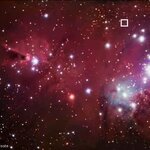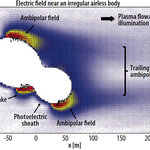Space

The HESS-II (High Energy Stereoscopic System) telescope in Namibia has detected gamma rays of only 30 Giga electron volts (GeV) from the Vela pulsar, the first pulsar to be detected by HESS and the second to be spotted by ground-based gamma ray telescopes.
The HESS experiment in Namibia is the first Cherenkov system with telescopes of different sizes detecting cosmic TeV gamma rays in sync. A fifth 28-meter telescope, placed at the center of the other four 12-meter telescopes, lowers the energy range under study down to 30 GeV. HESS-II has passed the firing test because scientists have…

Acoustic vibrations – sound waves – are produced by radiation pressure inside stars. While physicists have long posited that young stars vibrate differently than older stars, a new study says it is the first to confirm these predications using concrete data from outer space.
First author Konstanze Zwintz, a postdoctoral researcher at KU Leuven's Institute for Astronomy, and her colleagues studied the vibrations of 34 stars aged under 10 million years and sized between one and four times the mass of our sun.
"Our data shows that the youngest stars vibrate slower while the stars nearer to…

At first glance, Titan, the largest moon of Saturn, has little in common with Earth. Titan's surface temperature dips tp nearly 300 F below zero, its seas slosh with liquid methane, and its sky is a murky shade of creamsicle.
Yet an analysis of mysterious features spotted on Titan indicates that it experiences one of the same global processes that is important here on Earth -
seasonal cycles analogous to Earth's, and that the moon's surface conditions change as the Titan year unfolds.
.
The Cassini satellite has been orbiting Saturn and its moons since 2004. Stanford's Howard…

We don't know what dark matter is but we know it must be. And now, computer hypothetically, we know it a little better, thanks to new supercomputer simulations showing a possible evolution of our corner of the cosmos, the Local Group, from the Big Bang to the present day.
The physicists hope their simulations could improve understanding of dark matter, a mysterious substance believed to make up 85 percent of the mass of the Universe. The belief is that clumps of dark matter – halos – that emerged from the early Universe, trapped intergalactic gas and became the birthplaces of…

Surrounding the sun is a vast atmosphere of solar particles, through which magnetic fields swarm, solar flares erupt, and gigantic columns of material rise, fall and jostle each other around. We call it the corona.
This corona, is even larger than thought, extending out some 5 million miles above the sun's surface *the equivalent of 12 solar radii), according to data from NASA's Solar Terrestrial Relations Observatory. This has implications for NASA's upcoming Solar Probe Plus mission, which is due to launch in 2018 and will go closer to the sun than any man-made technology ever…

Space looks empty the same way that nature sounds quiet. Unlike nature, space actually is a soundless vacuum, but it's not a void. Invisible to human eyes, space flows with electric activity. NASA is developing plans to send humans to an asteroid, and wants to know more about the electrical environment explorers will encounter there.
A solar wind blown from the surface of the sun at about a million miles per hour flows around all solar system objects, forming swirling eddies and vortices in its wake. Magnetic fields carried by the solar wind warp, twist, and snap as they slam into the…

We can't even define dark matter, other than it being some blanket term for something that must exist due to unexplainable gravitational influence on the movements and appearance of stars or galaxies.
Based on indirect evidence, astronomers believe that dark matter is the dominant type of matter in the Universe – everything else has been conjecture. But astronomers using high-energy observatories believe they may have discovered a clue that hints at this elusive invisible ingredient.
Galaxy clusters not only contain hundreds of galaxies, but also a huge amount of hot gas…

IAstronomers have discovered a bright, mysterious geologic object in
radar images of Ligeia Mare, the second-largest sea on Saturn's moon Titan.
on
Scientifically speaking, this is a transient feature. They want to call it a magic island and so do we. Titan, the largest of Saturn's 62 known moons, is a world of lakes and seas. The moon – smaller than our own planet – bears close resemblance to watery Earth, with wind and rain driving the creation of strikingly familiar landscapes. Under its thick, hazy nitrogen-methane atmosphere, astronomers have found mountains, dunes and lakes…

New observations made using NASA's Hubble Space Telescope show that dwarf galaxies are responsible for forming a large proportion of the universe's stars.
The result supports a decade-long investigation into whether there is a link between a galaxy's mass and its star-forming activity, and helps paint a consistent picture of how galaxies grew and evolved 3.5 to 6 billion years after the beginning of the universe.
Previous studies of star-forming galaxies were restricted to the analysis of mid- or high-mass galaxies, leaving out the numerous dwarf galaxies that existed in this era of…

A misconception arises when we ask people about the role that gravity plays in space.
If you watch movies set in space — or for that matter, read statements from NASA —you will be led to think that gravity is absent in space. After all, people often refer to space as a “zero gravity” environment (the movie 2001: A Space Odyssey famously showed a complex set of instructions for its “zero gravity toilet”), and NASA usually refers to the conditions in orbit as “microgravity.”
My new book, What Is Relativity? An Introduction to Einstein’s Theories, And Why They Matter, tackles this…